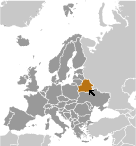World Atlas: Belarus. On this page you can see the map, country flag and many detailed information about the people, history and economy of Belarus.

Here you can find online selected information about the geography, inhabitants, government, economy and history of Belarus. Included are selected statistics, an overview map and the detailed map of Belarus. But let's start with the flag of Belarus here:
Belarus - Overview:
What you should know about Belarus? Let's start with this: After seven decades as a constituent republic of the USSR, Belarus attained its independence in 1991. It has retained closer political and economic ties to Russia than have any of the other former Soviet republics. Belarus and Russia signed a treaty on a two-state union on 8 December 1999 envisioning greater political and economic integration. Although Belarus agreed to a framework to carry out the accord, serious implementation has yet to take place. Since his election in July 1994 as the country's first and only directly elected president, Aleksandr Lukashenko has steadily consolidated his power through authoritarian means and a centralized economic system. Government restrictions on political and civil freedoms, freedom of speech and the press, peaceful assembly, and religion have remained in place.
Geography of Belarus
 Where on the globe is Belarus? The location of this country is Eastern Europe, east of Poland. Total area of Belarus is 207,600 sq km, of which 202,900 sq km is land. So this is quite a large country. How could we describe the terrain of the country? This way: generally flat with much marshland. The lowest point of Belarus is Nyoman River 90 m, the highest point Dzyarzhynskaya Hara 346 m. And the climate is cold winters, cool and moist summers; transitional between continental and maritime.
Where on the globe is Belarus? The location of this country is Eastern Europe, east of Poland. Total area of Belarus is 207,600 sq km, of which 202,900 sq km is land. So this is quite a large country. How could we describe the terrain of the country? This way: generally flat with much marshland. The lowest point of Belarus is Nyoman River 90 m, the highest point Dzyarzhynskaya Hara 346 m. And the climate is cold winters, cool and moist summers; transitional between continental and maritime.
Inhabitants of Belarus
Let's take a look how many people live in Belarus. The number is: 9,549,747 (July 2017 est.). So this is not very populous country. Who lives here? Belarusian 83.7%, Russian 8.3%, Polish 3.1%, Ukrainian 1.7%, other 2.4%, unspecified 0.9% (2009 est.). What are the languages in Belarus? Russian (official) 70.2%, Belarusian (official) 23.4%, other 3.1% (includes small Polish- and Ukrainian-speaking minorities), unspecified 3.3% (2009 est.). And the religions: Orthodox 48.3%, Catholic 7.1%, other 3.5%, non-believers 41.1% (2011 est.). How old are the people in average? 40 years. We have to add that this number is the median - so one half of the people is older than this, one half is younger. And what is their life expectancy (at birth)? This: 73 years. Where the people live in Belarus? Here: a fairly even distribution throughout most of the country, with urban areas attracting larger and denser populations. The major urban areas of Belarus are: Minsk (capital) 1.915 million (2015).
Government and Economy of Belarus
The capital of Belarus is Minsk and the government type presidential republic in name, although in fact a dictatorship. Let's take a look at the administrative divisions - 6 provinces (voblastsi, singular - voblasts') and 1 municipality (horad); Brest, Homyel' (Gomel'), Horad Minsk (Minsk City), Hrodna (Grodno), Mahilyow (Mogilev), Minsk, Vitsyebsk (Vitebsk). Regarding the economy of Belarus, important industrial products are metal-cutting machine tools, tractors, trucks, earthmovers, motorcycles, synthetic fibers, fertilizer, textiles, refrigerators, washing machines and other household appliances. Important agricultural products are grain, potatoes, vegetables, sugar beets, flax; beef, milk. The most important export commodities are machinery and equipment, mineral products, chemicals, metals, textiles, foodstuffs and the most important export partners are Russia 46.3%, Ukraine 12.2%, UK 4.6%, Germany 4% (2016). The most important import commodities are mineral products, machinery and equipment, chemicals, foodstuffs, metals and the most important import partners are Russia 55.5%, China 7.8%, Germany 4.9%, Poland 4.4% (2016). How rich is Belarus and how rich are people in this country? The most important number here is GDP per capita (PPP): $18,600 (2017 est.). This is quite good. Let's add that this means Gross Domestic Product per person, which is recalculated with respect to the relative cost of local goods and services. And one more important number - population below poverty line: 5.7% (2016 est.).